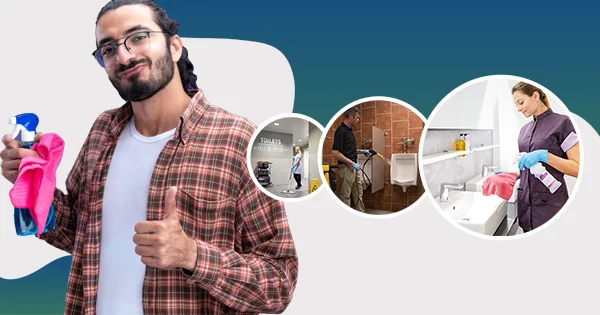Maintaining clean and hygienic restrooms in retail settings is of utmost importance. Retail stores are frequented by many customers every day, and the condition of the restrooms can have a significant impact on their overall experience. Clean and well-maintained restrooms not only promote good hygiene but also contribute to customer satisfaction and the reputation of the business. In this article, we will discuss the importance of deep cleaning retail restrooms, the risks associated with poorly maintained restrooms, developing a comprehensive cleaning plan, essential cleaning tools and supplies, best practices for cleaning restroom floors and walls, tips for tackling tough stains and odours, maintaining hygienic surfaces and fixtures, addressing common restroom complaints, training and managing cleaning staff, and monitoring and evaluating your cleaning program.
The Importance of Deep Cleaning Retail Restrooms
Deep cleaning is necessary for retail restrooms to ensure they are free from dirt, grime, bacteria, and other contaminants. Regular surface cleaning may not be enough to remove all the hidden germs that can accumulate in hard-to-reach areas. Deep cleaning involves thorough cleaning of all surfaces, including floors, walls, fixtures, and drains. For professional assistance, businesses can rely on Deep Cleaning in UK services to ensure a high standard of hygiene.
Deep cleaning of retail restrooms offers several benefits. Firstly, it improves hygiene by removing bacteria and other contaminants that can cause illness. Secondly, it enhances customer satisfaction, creating a positive impression of the store. Lastly, it prolongs the lifespan of restroom fixtures by preventing the buildup of dirt and grime.
Understanding the Risks of Poorly Maintained Restrooms
Poorly maintained restrooms pose several health and safety risks. They can become breeding grounds for bacteria and viruses, leading to the spread of infections. Unpleasant odours and plumbing issues such as leaks or clogs can create further problems. Beyond health risks, dirty restrooms can hurt customer experience and damage the store’s reputation.
Developing a Comprehensive Cleaning Plan
Having a comprehensive cleaning plan is essential for maintaining clean restrooms. A cleaning plan should include daily tasks like emptying trash bins and restocking supplies, as well as weekly or monthly deep cleaning of floors, walls, fixtures, and drains. Cleaning plans should account for peak times of foot traffic and allocate sufficient resources for these periods. Retailers can benefit from Commercial Cleaning in UK solutions to implement effective and tailored cleaning schedules.
Essential Cleaning Tools and Supplies
To clean retail restrooms effectively, high-quality tools and supplies are crucial. Essential tools include mops, brooms, scrub brushes, microfiber cloths, and vacuum cleaners. Cleaning supplies such as disinfectants, detergents, glass cleaners, toilet bowl cleaners, and odour neutralisers help maintain a hygienic environment.
Best Practices for Cleaning Restroom Floors and Walls
Proper techniques and cleaning solutions are key for maintaining floors and walls. Sweep or vacuum floors before mopping with a suitable cleaning solution. For walls, work from top to bottom using a microfiber cloth or sponge with mild detergent, focusing on high-contact areas around sinks, toilets, and urinals. Rinse and dry thoroughly to prevent water marks.
Tips for Tackling Tough Stains and Odours
Use specialised stain removers for stubborn stains, testing in inconspicuous areas first. To combat odours, identify the source and disinfect affected areas such as drains, toilets, or urinals. Odour neutralisers or restroom-safe air fresheners can help maintain a pleasant environment.
Maintaining Hygienic Surfaces and Fixtures
Regular cleaning of countertops, sinks, faucets, and door handles prevents the spread of germs. Toilet bowls, urinals, and sinks should be cleaned thoroughly with appropriate solutions, paying attention to areas prone to buildup. Rinse and dry surfaces properly.
Addressing Common Restroom Complaints
Common complaints include clogged toilets, empty soap dispensers, overflowing trash bins, and unpleasant odours. Implement a system for regular maintenance and inspection, restocking supplies, and fixing any issues promptly. Collecting customer feedback through suggestion boxes or online forms can help improve restroom standards.
Training and Managing Your Cleaning Staff
Effective training ensures cleaning staff know proper techniques, product use, and safety procedures. Staff should also be trained in customer service and complaint handling. Regular supervision, feedback, and recognition help maintain high cleanliness standards.
Monitoring and Evaluating Your Cleaning Program
Regular inspections and tracking metrics such as customer complaints and restroom usage ensure the cleaning program is effective. Adjustments can be made based on feedback or observed issues. Continuous communication with staff and customers provides valuable insights into restroom cleanliness.
Conclusion
Maintaining clean and hygienic restrooms in retail settings is crucial for good hygiene, customer satisfaction, and business reputation. Deep cleaning, comprehensive planning, use of proper tools, tackling stains and odours, maintaining surfaces, addressing complaints, and staff management are all essential steps. Prioritising restroom cleanliness ensures a welcoming and positive environment for customers.


